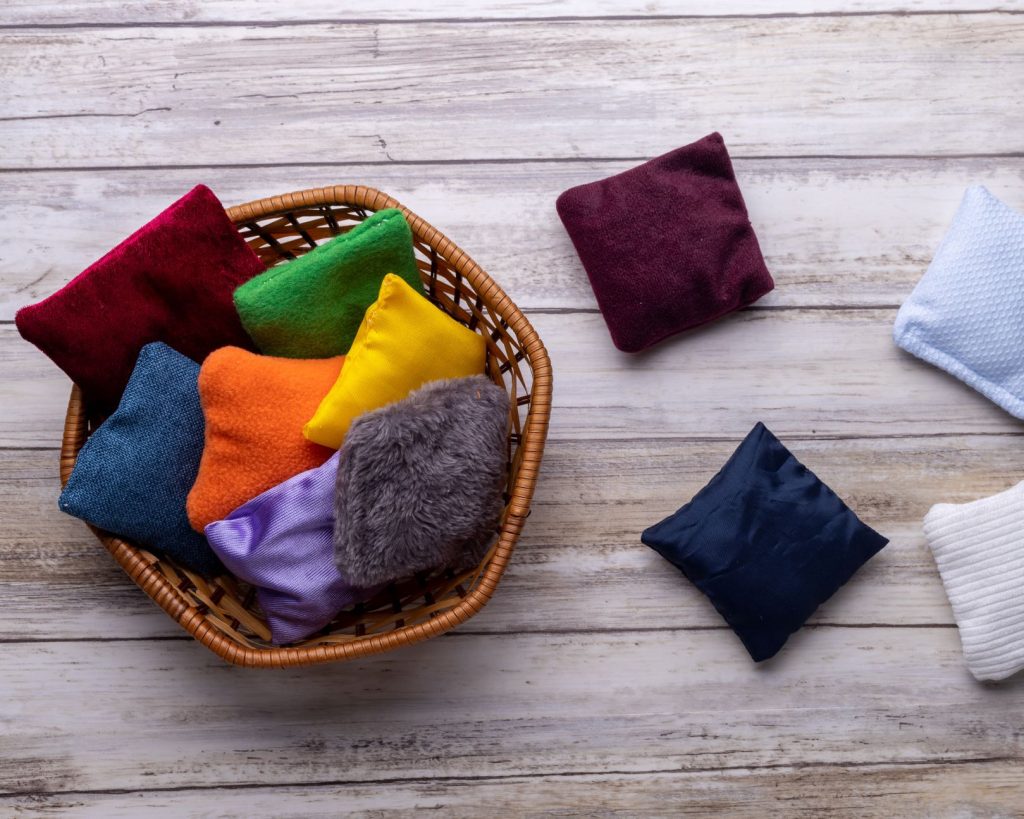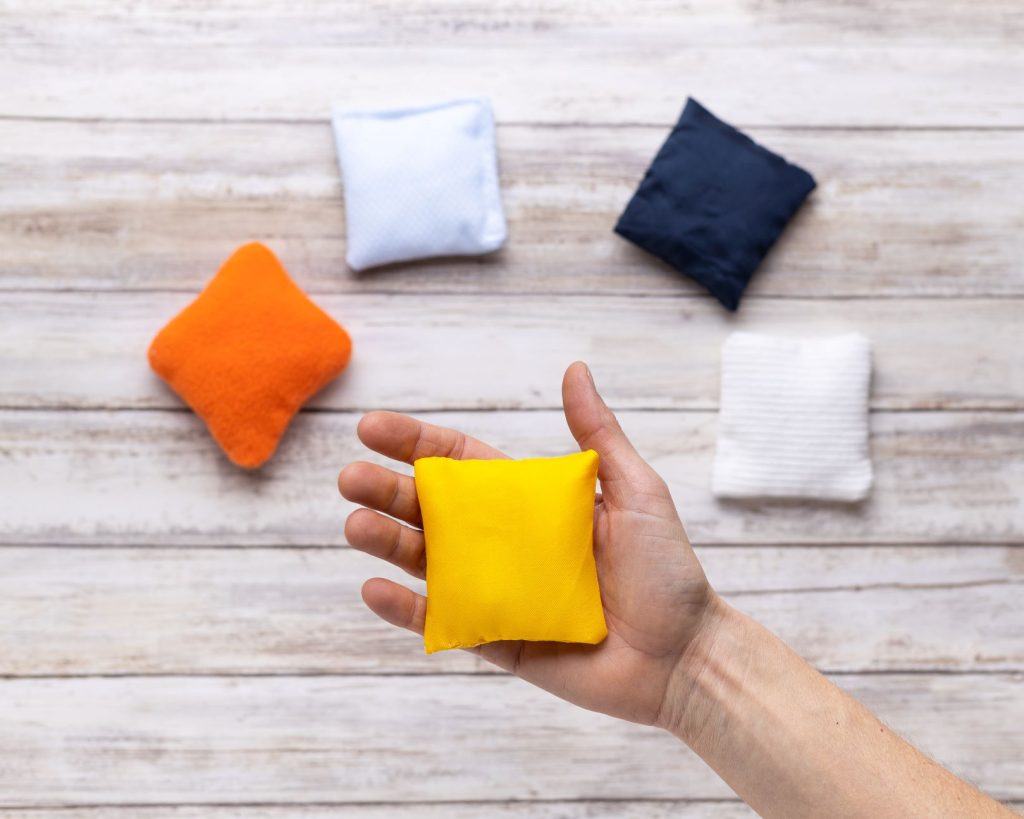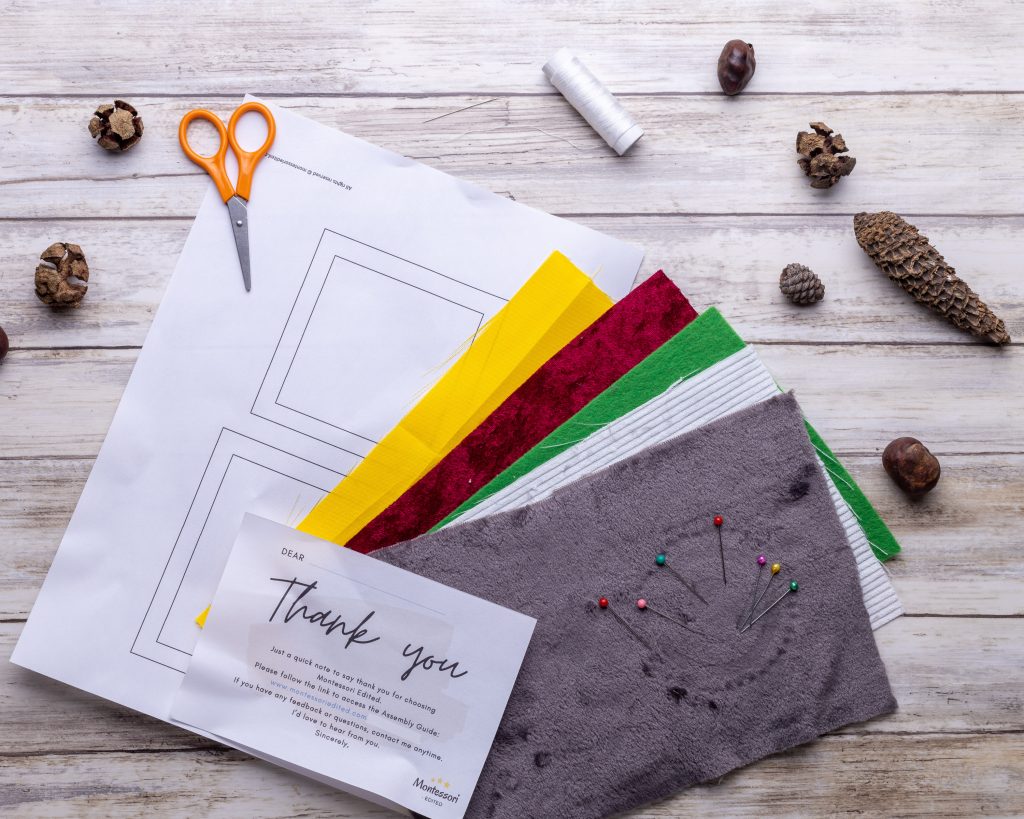In my opinion, sensory bean bags are the most underrated learning toys, like, ever! I wonder why? Most probably because they are so simple and obvious that people find it hard to imagine what these little pouches can do to satisfy their small children’s developmental needs. Oh, and did you notice that I used the word ‘small children’ instead of ‘babies’? This is because, while you can start using these Montessori inspired sensory toys from around 6 months old (or when your baby can confidently sit up), you can use them literally for years! In every stage of development they offer a new idea to explore. Let me walk you through these in this post.
WHAT DO THEY LOOK LIKE?
The Sensory Bean Bags are an adaptation of the Montessori Fabric Box, which is used in the 3-6 years old’s classroom (read this blog post for more information). The direct objective here is the development of the tactile sense as every bag is made of a textured fabric. The colour and the feel of each bag is different, to provide a rich visual and tactile experience.

SO WHY IS THE FABRIC SENSORY BALL SO ATTRACTIVE FOR YOUR BABY?
Just imagine – you’re a baby, about 6 months old. You’ve just learnt how to sit up by yourself and you are finally learning how to control your body so it doesn’t fall over every, single, time your balance changes, but it’s hard work! Luckily, your mummy sat you in a corner to support you and you’re sitting on a soft surface to minimise the damage when you do topple over. Baby steps, as they say.
You like being up here, you can see much further now and everything has a new perspective. But the most important thing is that your hands are free to explore! You now have the control and the muscle strength to pick up objects and examine them by yourself. Maybe you have already been practicing with the Montessori Puzzle Ball or the Fabric Sensory Ball.
These skills give you a great sense of freedom and achievement and the desire to explore. You use all your senses to soak up the world around you and every new object you touch gives you a brand-spanking new sensory experience. Your thirst to touch, see, smell, hear and taste everything around you is the most important factor in your development.
And then one day, these small little bags appear in front of you. How would you react? I’m thinking, head simply exploding, running around screaming ‘FINALLY’, something along those lines?

WHAT ARE THE SCIENTIFIC BENEFITS OF THE SENSORY BEAN BAGS?
They…
- stimulate the visual and the tactile sense, but depending on what you fill them with, can train other senses as well
- invite close observation and focus
- continue training hand and body control
- work the fine and gross motor skills
- develop creativity and thinking by encouraging your baby to try out different ways to manipulate them
- with older children, these bags can be used to introduce new vocabulary, colours, counting, etc.
TIPS AND TRICKS
If you are keen to follow the Montessori approach to toys, I would respect the principle of Isolating the Senses (read more about the most relevant aspects of the Montessori philosophy for babies in this post). I would either fill up all the little bags with the same material, so as not to take the attention away from the texture of the different types of fabric, or make all the bags using only one type of fabric and fill them up with different objects.
Nevertheless, you can combine the two ideas and fill up each textured bag with a different filling.
WHAT TO USE AS FILLING?
There is a huge scope here to provide your baby with an amazing amount of sensory input. The possibilities are literally endless!
Tactile Sense
You can just go into your kitchen and pour everything you find in your cupboard in them! Rice, lentils, chickpeas, pasta, quinoa… whatever you have at hand.
Auditory sense
For ‘noisy bags’, use the plastic packaging from a cereal bag, or find a small, flat box, fill it with rice, and sew that inside one of the sensory bags.
Sense of smell
You can use lavender, fresh rosemary or vanilla sticks to stimulate the sense of smell.
DIY THEM!
It is SO EASY to make these bags at home! Do you have some leftover fabric lying around? Can you sew in a straight line? Then go for it! This sewing project is very forgiving. It really doesn’t matter if your lines are not perfectly straight or your margins do not have the same thickness everywhere. These are the perfect DIY sewing projects for babies!
If you’d like to buy the Sensory Bags you see on the photos, head over to my Shop. There you can find three colour selections, all with carefully chosen textured fabrics. They come with two template sizes (one for small babies and another for older ones), and a VERY detailed Instruction Guide.

FINAL THOUGHTS
The Sensory Bean Bags are great learning toys, not only for babies but also for toddlers and even young children. They are open-ended, encourage creativity, exploration, discovery and they are also great fun to play with! You can really expand the sensory experience of them by using a variety of fabrics and fillings, engaging all their senses.
Click here to read more about how the Montessori Visual Mobiles, the Montessori Tactile Mobiles or the Sensory Baby Toys help your baby’s development.
How did your baby react to this material? Please share your photos on my Instagram site. #montessoriedited, @montessoriedited
